airbag Lancia Musa 2012 Owner handbook (in English)
[x] Cancel search | Manufacturer: LANCIA, Model Year: 2012, Model line: Musa, Model: Lancia Musa 2012Pages: 218, PDF Size: 3.91 MB
Page 9 of 218

8
SAFETY
STARTING
AND DRIVING
WARNING
LIGHTS AND
MESSAGES
IN AN
EMERGENCY
MAINTENANCE
AND CARE
TECHNICAL
SPECIFICA-
TIONS
INDEX
DASHBOARD
AND
CONTROLS
L0D0374m
1.Side air vents - 2.Left stalk- 3.Left upper box - 4.Right stalk - 5.Central air vents - 6.Instrument panel - 7.Right up-
per box - 8.Oddment compartment 9Passenger airbag - 10.HVAC controls - 11.Control buttons 12Sound system (for ver-
sions/markets, where provided) - 13.Ignition switch - 14.Driver airbag - 15.Cruise control (for versions/markets, where
provided).
DASHBOARD
The presence and position of the controls, instruments and gauges may vary depending on the version.
There are several solutions for the central upper and lower console according to the chosen customisations: see the following
figures.
fig. 1
Page 27 of 218
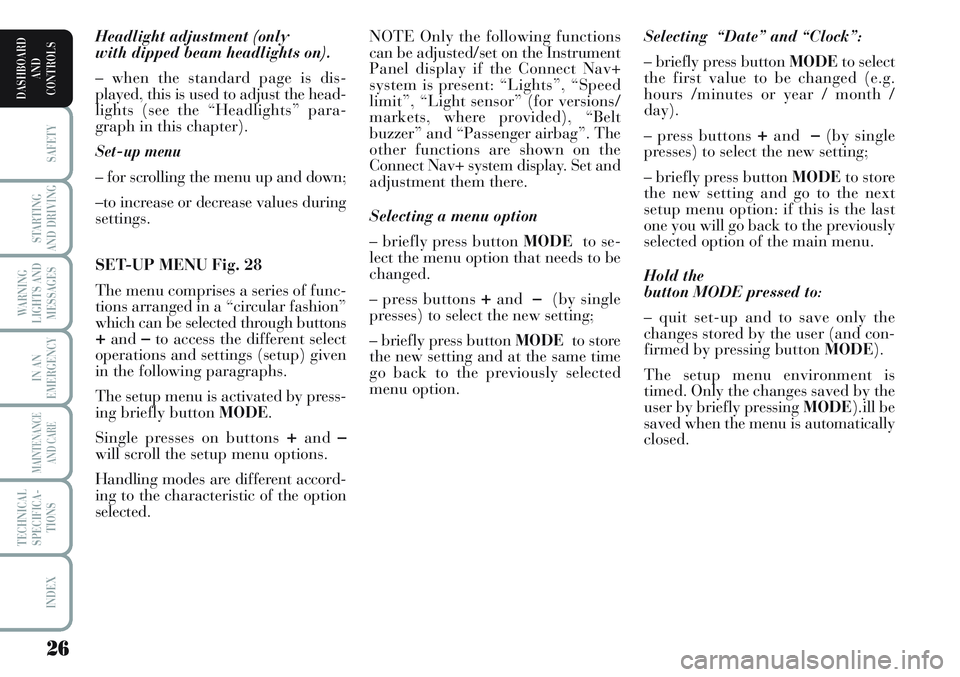
26
SAFETY
STARTING
AND DRIVING
WARNING
LIGHTS AND
MESSAGES
IN AN
EMERGENCY
MAINTENANCE
AND CARE
TECHNICAL
SPECIFICA-
TIONS
INDEX
DASHBOARD
AND
CONTROLS
Headlight adjustment (only
with dipped beam headlights on).
– when the standard page is dis-
played, this is used to adjust the head-
lights (see the “Headlights” para-
graph in this chapter).
Set-up menu
– for scrolling the menu up and down;
–to increase or decrease values during
settings.
SET-UP MENU Fig. 28
The menu comprises a series of func-
tions arranged in a “circular fashion”
which can be selected through buttons
+and–to access the different select
operations and settings (setup) given
in the following paragraphs.
The setup menu is activated by press-
ing briefly button MODE.
Single presses on buttons
+and–will scroll the setup menu options.
Handling modes are different accord-
ing to the characteristic of the option
selected.Selecting “Date” and “Clock”:
– briefly press button MODEto select
the first value to be changed (e.g.
hours /minutes or year / month /
day).
– press buttons
+and–(by single
presses) to select the new setting;
– briefly press button MODEto store
the new setting and go to the next
setup menu option: if this is the last
one you will go back to the previously
selected option of the main menu.
Hold the
button MODE pressed to:
– quit set-up and to save only the
changes stored by the user (and con-
firmed by pressing button MODE).
The setup menu environment is
timed. Only the changes saved by the
user by briefly pressing MODE).ill be
saved when the menu is automatically
closed. NOTE Only the following functions
can be adjusted/set on the Instrument
Panel display if the Connect Nav+
system is present: “Lights”, “Speed
limit”, “Light sensor” (for versions/
markets, where provided), “Belt
buzzer” and “Passenger airbag”. The
other functions are shown on the
Connect Nav+ system display. Set and
adjustment them there.
Selecting a menu option
– briefly press button MODEto se-
lect the menu option that needs to be
changed.
– press buttons
+and–(by single
presses) to select the new setting;
– briefly press button MODEto store
the new setting and at the same time
go back to the previously selected
menu option.
Page 28 of 218
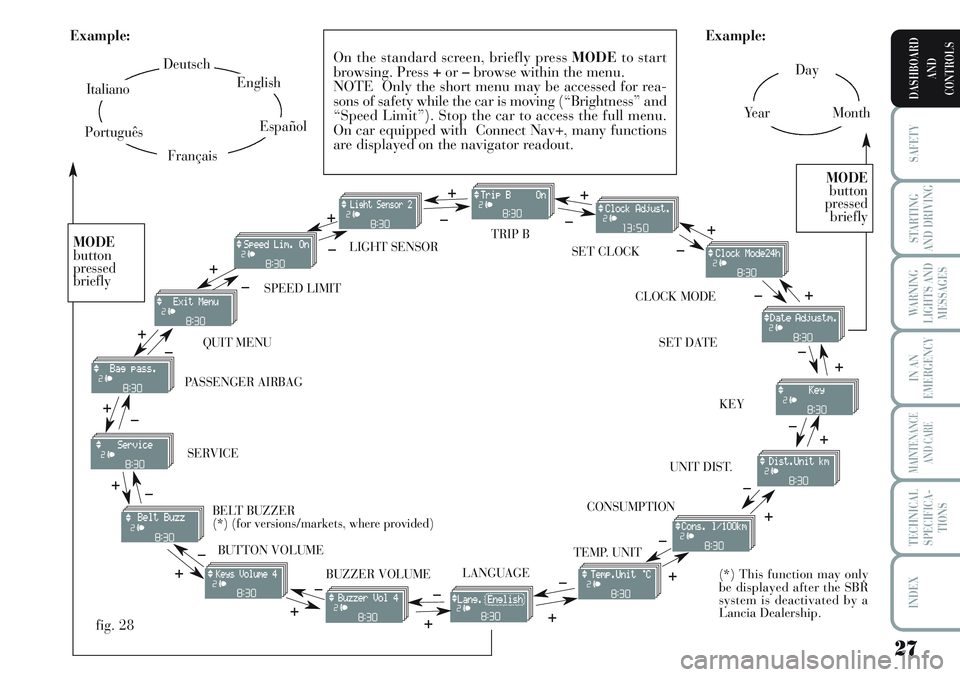
27
SAFETY
STARTING
AND DRIVING
WARNING
LIGHTS AND
MESSAGES
IN AN
EMERGENCY
MAINTENANCE
AND CARE
TECHNICAL
SPECIFICA-
TIONS
INDEX
DASHBOARD
AND
CONTROLS
Day
Ye a rMonth Example:
CONSUMPTION QUIT MENU SPEED LIMIT SET CLOCK LIGHT SENSOR TRIP B
CLOCK MODE
SET DATE
KEY
UNIT DIST.
BUTTON VOLUME
BUZZER VOLUME SERVICE
LANGUAGETEMP. UNIT
Example:
– +
+– – –
+ +
–
–
+
+++
–––
+ +
–
MODE
button
pressed
briefly
On the standard screen, briefly press MODEto start
browsing. Press +or–browse within the menu.
NOTE Only the short menu may be accessed for rea-
sons of safety while the car is moving (“Brightness” and
“Speed Limit”). Stop the car to access the full menu.
On car equipped with Connect Nav+, many functions
are displayed on the navigator readout.
–
+ +
–
MODE
button
pressed
briefly
Deutsch
English
Español
Italiano
Português
Français
(*) This function may only
be displayed after the SBR
system is deactivated by a
Lancia Dealership.
fig. 28
+
– +
–+
–
+
–
+ –
BELT BUZZER
(*) (for versions/markets, where provided) PASSENGER AIRBAG
Page 35 of 218

34
SAFETY
STARTING
AND DRIVING
WARNING
LIGHTS AND
MESSAGES
IN AN
EMERGENCY
MAINTENANCE
AND CARE
TECHNICAL
SPECIFICA-
TIONS
INDEX
DASHBOARD
AND
CONTROLS
Activating/deactivating the
passenger front and side airbag
on/off (passenger bag)
(for versions/markets, where provided)
This function shall be used to acti-
vate/deactivate the passenger’s airbag.
Proceed as follows:
❒press MODEand after the message
(Bag pass Off) (deactivate) or (Bag
pass On) (activate) appears by
pressing buttons +and–, press the
MODEbutton again;
❒the confirmation request message
will be displayed;
❒press buttons +o–to select (Yes)
(to confirm activation/deactivation)
or (No) (to abort);
❒briefly press button MODE: the
display shows a message confirm-
ing the selected value. Now, go
back to the menu screen or press
the button for a prolonged time to
go back to the standard screen
without storing the settings.
MODE
MODE
MODE
– +
L0D2169g L0D2170g
L0D2171g L0D2172g
L0D2173g L0D2174gL0D2174g
L0D2175gL0D2176g
– +
– +
– +
Page 96 of 218
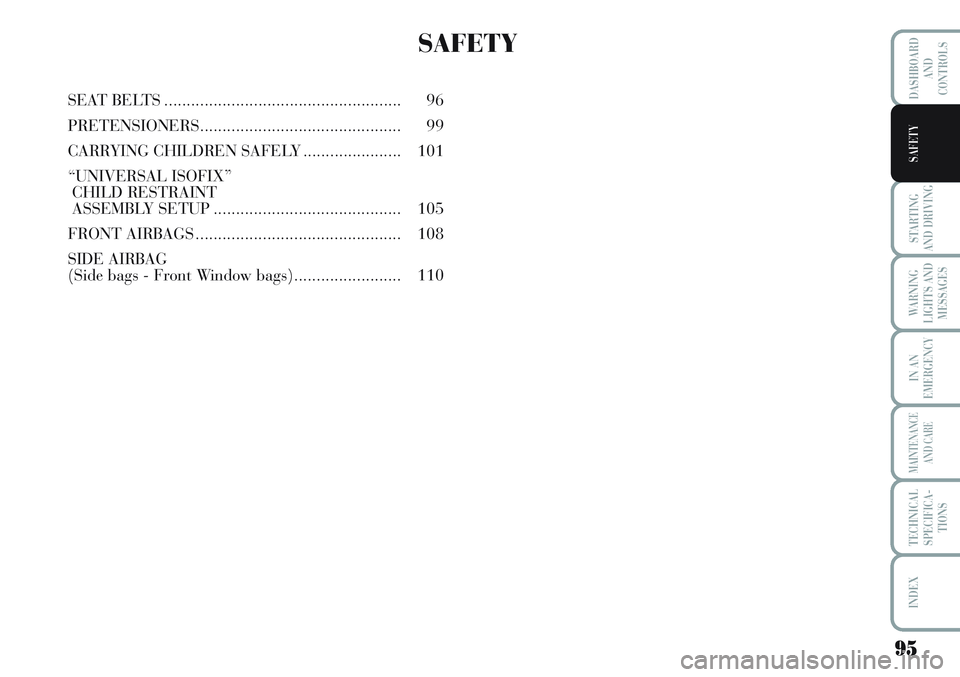
95
STARTING
AND DRIVING
WARNING
LIGHTS AND
MESSAGES
IN AN
EMERGENCY
MAINTENANCE
AND CARE
TECHNICAL
SPECIFICA-
TIONS
INDEX
DASHBOARD
AND
CONTROLS
SAFETY
SAFETY
SEAT BELTS ..................................................... 96
PRETENSIONERS............................................. 99
CARRYING CHILDREN SAFELY ...................... 101
“UNIVERSAL ISOFIX”
CHILD RESTRAINT
ASSEMBLY SETUP.......................................... 105
FRONT AIRBAGS.............................................. 108
SIDE AIRBAG
(Side bags - Front Window bags)........................ 110
Page 103 of 218

102
STARTING
AND DRIVING
WARNING
LIGHTS AND
MESSAGES
IN AN
EMERGENCY
MAINTENANCE
AND CARE
TECHNICAL
SPECIFICA-
TIONS
INDEX
DASHBOARD
AND
CONTROLS
SAFETY
The research results in relation to the
best protection for children is illus-
trated in European Regulation EEC-
R44 which divides the restraint sys-
tems into five groups in addition to
making their use compulsory:
Group 0 up to 10 kg of weight
Group 0+ up to 13 kg of weight
Group 1 9-18 kg of weight
Group 2 15-25 kg of weight
Group 3 22-36 kg of weight
As it may be noted, the groups over-
lap partly and in fact, there are de-
vices that cover more than one weight
group.
All child restraint devices must bear
the certification data, together with
the control brand, on a solidly fixed
label which must absolutely never be
removed.
When over 1.50 m in height, from the
point of view of restraint systems,
children are considered as adults and
have to wear the standard seat belts.
Lineaccessori Lancia includes child
restraint systems for each weight
group. These devices are recom-
mended having been specifically de-
signed for Lancia cars.
SEVERE DANGER: Do
not arrange child seats
facing backwards on the front seat
if the passenger’s airbag is en-
abled. Deployment of the airbag in
an accident could cause fatal in-
juries to the baby. It is advisable to
carry children on the rear seat,
which is the most protected posi-
tion in the event of an accident.
Child seats must not be fitted on
the front seat of cars fitted with a
passenger air bag, whose deploy-
ment in an accident could cause fa-
tal injuries to the baby regardless
of the seriousness of the impact.
WARNING
In case of need, the pas-
senger airbag can be de-
activated and children can
be place on the front seat.
It is very important to
check that the airbag has
been deactivated by means of the
amber warning light (see the chap-
ter on first and side airbags,
specifically the paragraph on pas-
senger front airbags). Move the
passenger’s seat as far back as
possible to avoid contact between
the child seat and the dashboard.
WARNING
Page 106 of 218
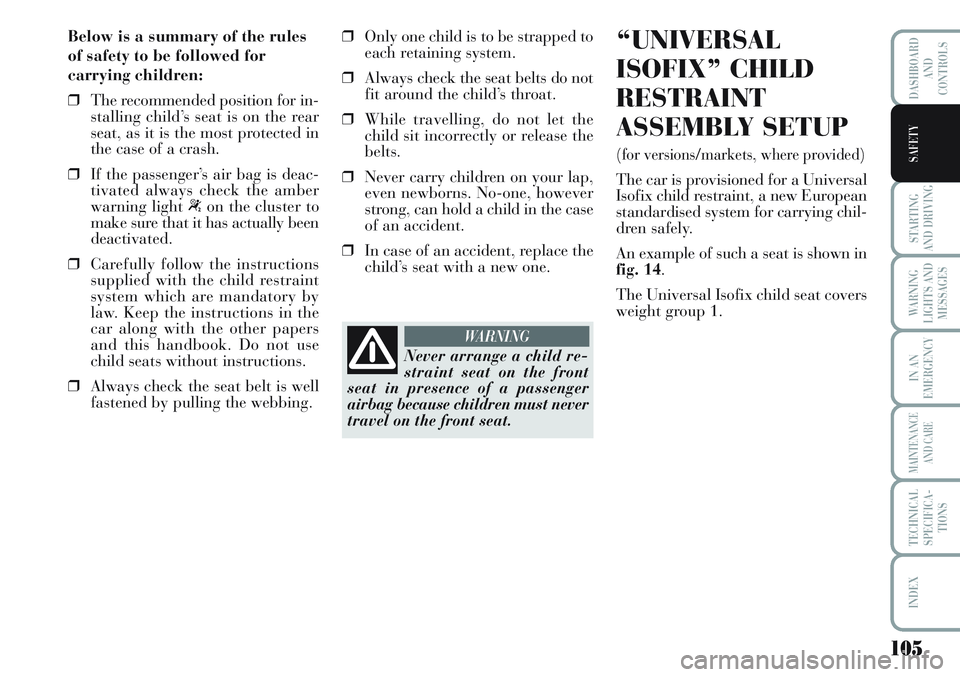
105
STARTING
AND DRIVING
WARNING
LIGHTS AND
MESSAGES
IN AN
EMERGENCY
MAINTENANCE
AND CARE
TECHNICAL
SPECIFICA-
TIONS
INDEX
DASHBOARD
AND
CONTROLS
SAFETY
Below is a summary of the rules
of safety to be followed for
carrying children:
❒The recommended position for in-
stalling child’s seat is on the rear
seat, as it is the most protected in
the case of a crash.
❒If the passenger’s air bag is deac-
tivated always check the amber
warning light “on the cluster to
make sure that it has actually been
deactivated.
❒Carefully follow the instructions
supplied with the child restraint
system which are mandatory by
law. Keep the instructions in the
car along with the other papers
and this handbook. Do not use
child seats without instructions.
❒Always check the seat belt is well
fastened by pulling the webbing.❒Only one child is to be strapped to
each retaining system.
❒Always check the seat belts do not
fit around the child’s throat.
❒While travelling, do not let the
child sit incorrectly or release the
belts.
❒Never carry children on your lap,
even newborns. No-one, however
strong, can hold a child in the case
of an accident.
❒In case of an accident, replace the
child’s seat with a new one. “UNIVERSAL
ISOFIX” CHILD
RESTRAINT
ASSEMBLY SETUP
(for versions/markets, where provided)
The car is provisioned for a Universal
Isofix child restraint, a new European
standardised system for carrying chil-
dren safely.
An example of such a seat is shown in
fig. 14.
The Universal Isofix child seat covers
weight group 1.
Never arrange a child re-
straint seat on the front
seat in presence of a passenger
airbag because children must never
travel on the front seat.
WARNING
Page 109 of 218

108
STARTING
AND DRIVING
WARNING
LIGHTS AND
MESSAGES
IN AN
EMERGENCY
MAINTENANCE
AND CARE
TECHNICAL
SPECIFICA-
TIONS
INDEX
DASHBOARD
AND
CONTROLS
SAFETY
FRONT AIRBAGS
The car is provided with front airbags
for the driver and passenger and win-
dow bags (head protection system). It
may be provided with optional front
side bags.
The front driver / passenger air bags
have been designed to protect the oc-
cupants in the event of head-on
crashes of medium-high severity, by
placing the cushion between the oc-
cupant and the steering wheel or
dashboard.
Front air bags are designed to protect
car’s occupants in front crashes and
therefore non-activation in other types
of collisions (side collisions, rear
shunts, roll-overs, etc.) is not a system
malfunction.
An electronic control unit will make
the bag inflate in the event of a frontal
crash.
The bag will inflate instantaneously
placing itself between the front occu-
pant’s body and the structures which
could cause injury. It will deflate im-
mediately afterwards.
Driver and passenger front airbags are
not a replacement of but complemen-
tary to the belts, which you are rec-
ommended to always wear, as speci-
fied by law in Europe and most non-
European countries.In the event of a collision, a person
not wearing a seat belt may be thrown
forward and con into contact with the
bag before it has fully opened. The
protection offered by the cushion is
reduced in such a case.
Front air bag may not be activated in
the following situations:
❒in collisions against highly de-
formable objects not affecting the
car front surface (e.g. bumper col-
lision against guard rail, etc.);
❒jamming of the car underneath
other vehicles or protective barri-
ers (e.g. underneath a truck or a
guard rail); in this case, the bags
would offer no additional protec-
tion with respect to the seat belt
and their deployment is unneces-
sary. No deployment in such cases
is consequently not the sign of a
fault.
The front airbags (driver and passen-
ger) are designed and calibrated to
protect front seat occupants who are
wearing seat belts. The volume of
front air bags at max. inflation fills
most of the space between the steer-
ing wheel and the driver and between
the dashboard and the passenger.FRONT AIR BAG ON DRIVER’S
SIDE, fig. 17
It consists of an instant-inflating cush-
ion contained in a special recess in the
centre of the steering wheel.
fig. 17L0C0416m
Page 110 of 218
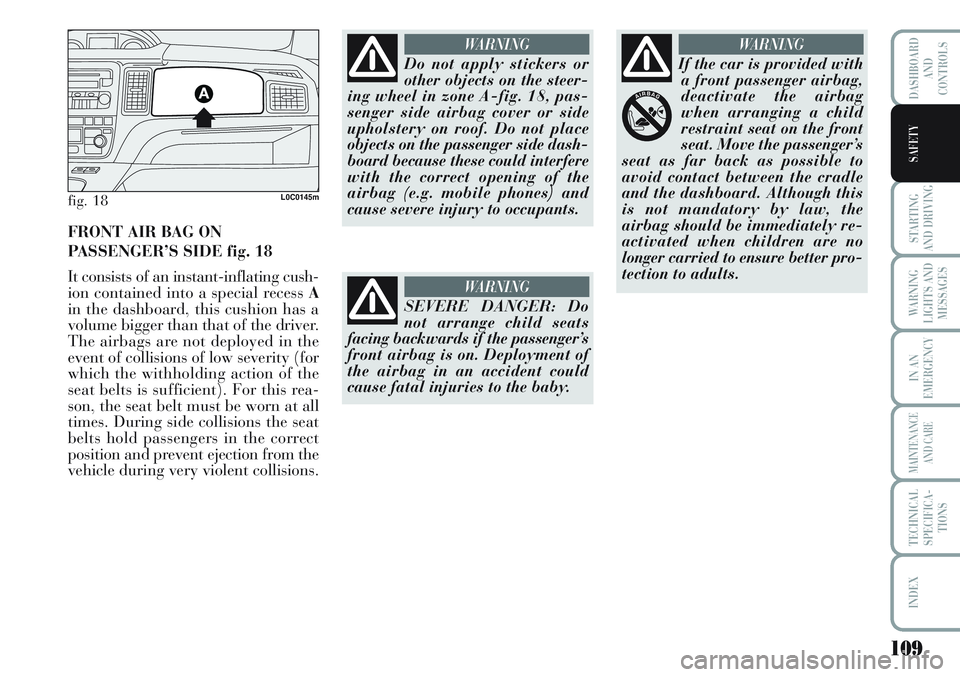
109
STARTING
AND DRIVING
WARNING
LIGHTS AND
MESSAGES
IN AN
EMERGENCY
MAINTENANCE
AND CARE
TECHNICAL
SPECIFICA-
TIONS
INDEX
DASHBOARD
AND
CONTROLS
SAFETY
fig. 18L0C0145m
FRONT AIR BAG ON
PASSENGER’S SIDE fig. 18
It consists of an instant-inflating cush-
ion contained into a special recess A
in the dashboard, this cushion has a
volume bigger than that of the driver.
The airbags are not deployed in the
event of collisions of low severity (for
which the withholding action of the
seat belts is sufficient). For this rea-
son, the seat belt must be worn at all
times. During side collisions the seat
belts hold passengers in the correct
position and prevent ejection from the
vehicle during very violent collisions.
Do not apply stickers or
other objects on the steer-
ing wheel in zone A-fig. 18, pas-
senger side airbag cover or side
upholstery on roof. Do not place
objects on the passenger side dash-
board because these could interfere
with the correct opening of the
airbag (e.g. mobile phones) and
cause severe injury to occupants.
WARNING
SEVERE DANGER: Do
not arrange child seats
facing backwards if the passenger’s
front airbag is on. Deployment of
the airbag in an accident could
cause fatal injuries to the baby.
WARNING
If the car is provided with
a front passenger airbag,
deactivate the airbag
when arranging a child
restraint seat on the front
seat. Move the passenger’s
seat as far back as possible to
avoid contact between the cradle
and the dashboard. Although this
is not mandatory by law, the
airbag should be immediately re-
activated when children are no
longer carried to ensure better pro-
tection to adults.
WARNING
Page 111 of 218

110
STARTING
AND DRIVING
WARNING
LIGHTS AND
MESSAGES
IN AN
EMERGENCY
MAINTENANCE
AND CARE
TECHNICAL
SPECIFICA-
TIONS
INDEX
DASHBOARD
AND
CONTROLS
SAFETY
MANUAL DEACTIVATION OF
PASSENGER’S FRONT AIRBAG
AND SIDE BAG
(for versions/markets, where provided)
Whenever a child needs to be carried
on the front seat, the passenger’s front
airbag and the Side Bag (for ver-
sions/markets, where provided) must
be deactivated.
The instrument panel warning light
“will stay on glowing steadily until
reactivating the passenger’s front air
bag and the side bag (for ver-
sions/markets, where provided).
SIDE BAGS
(Side bags -
Window bags)
(for versions/markets, where provided)
SIDE BAGS fig. 19
(for versions/markets, where provided)
The side bags are arranged in the
front seat backrests and inflate in-
stantly to protect the chest of occu-
pants in case of medium-to-high
severity crashes.
To deactivate the passen-
ger’s front air bag and the
side bag (for versions/markets,
where provided), refer to ““Multi-
functional display” paragraph in
the “Dashboard and controls”
chapter.
WARNING
Do not cover the backrest
of the front seats with cov-
ers which are not suitable for use
with side bags.
WARNING
fig. 19L0C0147m
fig. 20L0C0148m
WINDOW BAGS fig. 20
(for versions/markets, where provided)
It is formed by two “curtain” window
bags are located behind the side roof
upholstery and are covered by special
trimming. They were designed to pro-
tect the head of front and rear pas-
sengers in case of side collisions,
thanks to the wide cushion inflation
surface. Lancia Dealership has covers suitable
for seats with side bags.